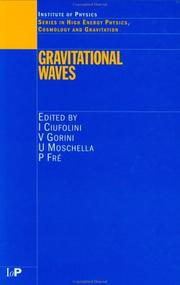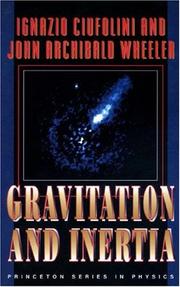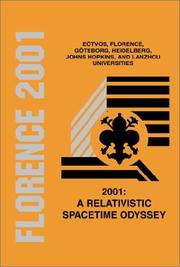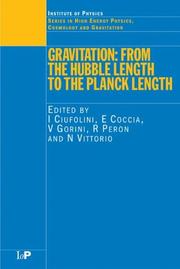| Listing 1 - 10 of 15 | << page >> |
Sort by
|

ISBN: 0750307412 9780750307413 Year: 2001 Publisher: London: Institute of physics,
Abstract | Keywords | Export | Availability | Bookmark
 Loading...
Loading...Choose an application
- Reference Manager
- EndNote
- RefWorks (Direct export to RefWorks)

ISBN: 0691033234 9780691033235 Year: 1995 Publisher: Princeton (N.J.) : Princeton university press,
Abstract | Keywords | Export | Availability | Bookmark
 Loading...
Loading...Choose an application
- Reference Manager
- EndNote
- RefWorks (Direct export to RefWorks)
Einstein's standard and battle-tested geometric theory of gravity--spacetime tells mass how to move and mass tells spacetime how to curve--is expounded in this book by Ignazio Ciufolini and John Wheeler. They give special attention to the theory's observational checks and to two of its consequences: the predicted existence of gravitomagnetism and the origin of inertia (local inertial frames) in Einstein's general relativity: inertia 'here' arises from mass 'there'.The authors explain the modern understanding of the link between gravitation and inertia in Einstein's theory, from the origin of inertia in some cosmological models of the universe, to the interpretation of the initial value formulation of Einstein's standard geometrodynamicsand from the devices and the methods used to determine the local inertial frames of reference, to the experiments used to detect and measure the "dragging of inertial frames of reference." In this book, Ciufolini and Wheeler emphasize present, past, and proposed tests of gravitational interaction, metric theories, and general relativity. They describe the numerous confirmations of the foundations of geometrodynamics and some proposed experiments, including space missions, to test some of its fundamental predictions--in particular gravitomagnetic field or "dragging of inertial frames" and gravitational waves.
Geometrodynamics --- General relativity (Physics) --- Inertia (Mechanics) --- 530.12 --- Gravitation --- Acceleration (Mechanics) --- Mass (Physics) --- Mechanics --- Field theory (Physics) --- Matter --- Physics --- Antigravity --- Centrifugal force --- Relativity (Physics) --- Geometry --- Relativistic theory of gravitation --- Relativity theory, General --- Relativity principle --- Properties --- Geometrodynamics. --- Gravitation. --- General relativity (Physics). --- Inertia (Mechanics). --- 530.12 Relativity principle
Book
ISBN: 9048137349 9786613003454 9048137357 1283003457 Year: 2010 Publisher: New York : Springer,
Abstract | Keywords | Export | Availability | Bookmark
 Loading...
Loading...Choose an application
- Reference Manager
- EndNote
- RefWorks (Direct export to RefWorks)
Observational and experimental data pertaining to gravity and cosmology are changing our view of the Universe. General relativity is a fundamental key for the understanding of these observations and its theory is undergoing a continuing enhancement of its intersection with observational and experimental data. These data include direct observations and experiments carried out in our solar system, among which there are direct gravitational wave astronomy, frame dragging and tests of gravitational theories from solar system and spacecraft observations. This book explores John Archibald Wheeler's seminal and enduring contributions in relativistic astrophysics and includes: the General Theory of Relativity and Wheeler's influence; recent developments in the confrontation of relativity with experiments; the theory describing gravitational radiation, and its detection in Earth-based and space-based interferometer detectors as well as in Earth-based bar detectors; the mathematical description of the initial value problem in relativity and applications to modeling gravitational wave sources via computational relativity; the phenomenon of frame dragging and its measurement by satellite observations. All of these areas were of direct interest to Professor John A. Wheeler and were seminally influenced by his ideas.
General relativity (Physics). --- Wheeler, John Archibald, 1911-2008 -- Influence. --- Wheeler, John Archibald, 1911-2008 -- Knowledge -- General relativity (Physics). --- General relativity (Physics) --- Gravitational fields --- Astrophysics --- Astronomy & Astrophysics --- Physics --- Physical Sciences & Mathematics --- Atomic Physics --- Wheeler, John Archibald, --- Relativistic theory of gravitation --- Relativity theory, General --- Hui-le, --- Huile, --- Uiler, Dzhon Archibalʹd, --- Wheeler, J. A. --- Classical and Quantum Gravitation, Relativity Theory. --- Cosmology. --- Astrophysics and Astroparticles. --- Gravitation --- Relativity (Physics) --- Gravitation. --- Astrophysics. --- Astronomical physics --- Astronomy --- Cosmic physics --- Deism --- Metaphysics --- Field theory (Physics) --- Matter --- Antigravity --- Centrifugal force --- Properties --- Influence. --- Knowledge
Book
ISBN: 0691190194 Year: 2018 Publisher: Princeton, NJ : Princeton University Press,
Abstract | Keywords | Export | Availability | Bookmark
 Loading...
Loading...Choose an application
- Reference Manager
- EndNote
- RefWorks (Direct export to RefWorks)
Einstein's standard and battle-tested geometric theory of gravity--spacetime tells mass how to move and mass tells spacetime how to curve--is expounded in this book by Ignazio Ciufolini and John Wheeler. They give special attention to the theory's observational checks and to two of its consequences: the predicted existence of gravitomagnetism and the origin of inertia (local inertial frames) in Einstein's general relativity: inertia here arises from mass there. The authors explain the modern understanding of the link between gravitation and inertia in Einstein's theory, from the origin of inertia in some cosmological models of the universe, to the interpretation of the initial value formulation of Einstein's standard geometrodynamics; and from the devices and the methods used to determine the local inertial frames of reference, to the experiments used to detect and measure the "dragging of inertial frames of reference." In this book, Ciufolini and Wheeler emphasize present, past, and proposed tests of gravitational interaction, metric theories, and general relativity. They describe the numerous confirmations of the foundations of geometrodynamics and some proposed experiments, including space missions, to test some of its fundamental predictions--in particular gravitomagnetic field or "dragging of inertial frames" and gravitational waves.
General relativity (Physics) --- Geometrodynamics. --- Gravitation. --- Inertia (Mechanics) --- SCIENCE / Physics / General. --- Geometry --- Relativity (Physics) --- Field theory (Physics) --- Matter --- Physics --- Antigravity --- Centrifugal force --- Relativistic theory of gravitation --- Relativity theory, General --- Gravitation --- Acceleration (Mechanics) --- Mass (Physics) --- Mechanics --- Properties
Multi
ISBN: 9789048137350 9789048137572 9789048137343 9789400732568 Year: 2010 Publisher: Dordrecht Springer Netherlands
Abstract | Keywords | Export | Availability | Bookmark
 Loading...
Loading...Choose an application
- Reference Manager
- EndNote
- RefWorks (Direct export to RefWorks)
Observational and experimental data pertaining to gravity and cosmology are changing our view of the Universe. General relativity is a fundamental key for the understanding of these observations and its theory is undergoing a continuing enhancement of its intersection with observational and experimental data. These data include direct observations and experiments carried out in our solar system, among which there are direct gravitational wave astronomy, frame dragging and tests of gravitational theories from solar system and spacecraft observations. This book explores John Archibald Wheeler's seminal and enduring contributions in relativistic astrophysics and includes: the General Theory of Relativity and Wheeler's influence; recent developments in the confrontation of relativity with experiments; the theory describing gravitational radiation, and its detection in Earth-based and space-based interferometer detectors as well as in Earth-based bar detectors; the mathematical description of the initial value problem in relativity and applications to modeling gravitational wave sources via computational relativity; the phenomenon of frame dragging and its measurement by satellite observations. All of these areas were of direct interest to Professor John A. Wheeler and were seminally influenced by his ideas.
Cosmology --- Astrophysics --- Theory of relativity. Unified field theory --- Geophysics --- zwaartekracht --- astrofysica --- relativiteitstheorie --- kosmologie
Book
ISBN: 9780691190198 Year: 2018 Publisher: Princeton, NJ
Abstract | Keywords | Export | Availability | Bookmark
 Loading...
Loading...Choose an application
- Reference Manager
- EndNote
- RefWorks (Direct export to RefWorks)
Digital
ISBN: 9780691190198 Year: 2018 Publisher: Princeton, N.J. Princeton University Press
Abstract | Keywords | Export | Availability | Bookmark
 Loading...
Loading...Choose an application
- Reference Manager
- EndNote
- RefWorks (Direct export to RefWorks)

ISBN: 9812791361 9789812791368 9789812380890 9812380892 Year: 2003 Publisher: River Edge, N.J. World Scientific
Abstract | Keywords | Export | Availability | Bookmark
 Loading...
Loading...Choose an application
- Reference Manager
- EndNote
- RefWorks (Direct export to RefWorks)
This volume offers a comprehensive overview of our understanding of gravity at both the experimental and the theoretical level. Critical reviews by experts cover topics ranging from astrophysics (anisotropies in the cosmic microwave background, gamma ray bursts, neutron stars and astroparticles), cosmology, the status of gravitational wave sources and detectors, verification of Newton's law at short distances, the equivalence principle, gravito-magnetism, measurement theory, time machines and the foundations of Einstein's theory, to string theory and loop quantum gravity.
General relativity (Physics) --- Particles (Nuclear physics)

ISBN: 0750309482 Year: 2005 Publisher: Bristol : Institute of physics,
Abstract | Keywords | Export | Availability | Bookmark
 Loading...
Loading...Choose an application
- Reference Manager
- EndNote
- RefWorks (Direct export to RefWorks)
Gravitation: From the Hubble Length to the Planck Length provides an overview of relativistic astrophysics, early universe physics, cosmology, and their interface with particle physics. Written by international experts, this reference presents up-to-date information on classical relativity, astrophysics, and theoretical and experimental particle physics. The introduction sets the scene and provides a context for the remaining chapters. Chapters cover an extensive array of topics, from refined experimental techniques in gravitational physics to cosmology and the quantum frontier. The book concludes with a discussion of the connection among particles, fields, strings, and branes.
Book
ISBN: 9789048137350 9789048137572 9789048137343 9789400732568 Year: 2010 Publisher: Dordrecht Springer Netherlands Imprint Springer
Abstract | Keywords | Export | Availability | Bookmark
 Loading...
Loading...Choose an application
- Reference Manager
- EndNote
- RefWorks (Direct export to RefWorks)
Observational and experimental data pertaining to gravity and cosmology are changing our view of the Universe. General relativity is a fundamental key for the understanding of these observations and its theory is undergoing a continuing enhancement of its intersection with observational and experimental data. These data include direct observations and experiments carried out in our solar system, among which there are direct gravitational wave astronomy, frame dragging and tests of gravitational theories from solar system and spacecraft observations. This book explores John Archibald Wheeler's seminal and enduring contributions in relativistic astrophysics and includes: the General Theory of Relativity and Wheeler's influence; recent developments in the confrontation of relativity with experiments; the theory describing gravitational radiation, and its detection in Earth-based and space-based interferometer detectors as well as in Earth-based bar detectors; the mathematical description of the initial value problem in relativity and applications to modeling gravitational wave sources via computational relativity; the phenomenon of frame dragging and its measurement by satellite observations. All of these areas were of direct interest to Professor John A. Wheeler and were seminally influenced by his ideas.
Cosmology --- Astrophysics --- Theory of relativity. Unified field theory --- Geophysics --- zwaartekracht --- astrofysica --- relativiteitstheorie --- kosmologie
| Listing 1 - 10 of 15 | << page >> |
Sort by
|

 Search
Search Feedback
Feedback About UniCat
About UniCat  Help
Help News
News